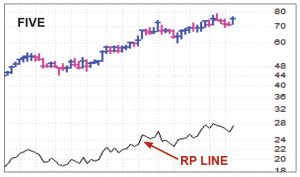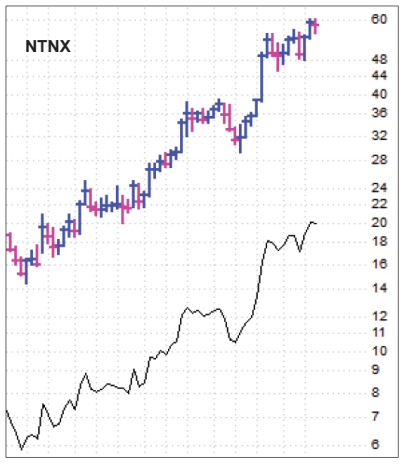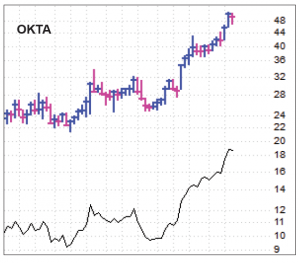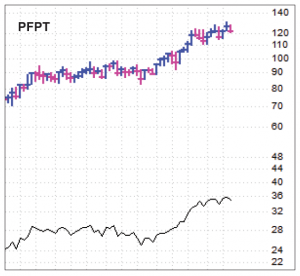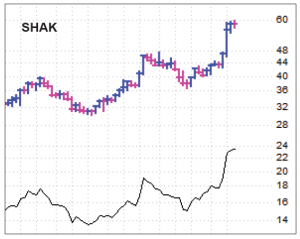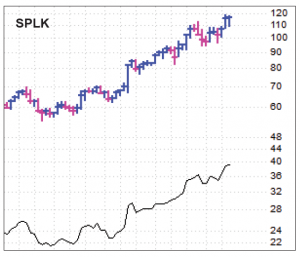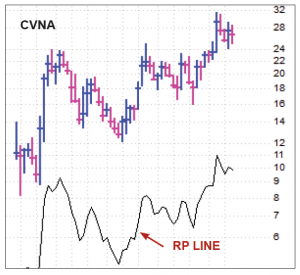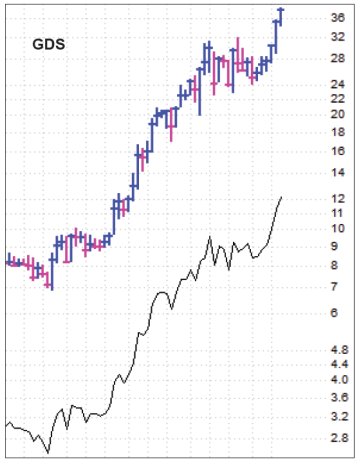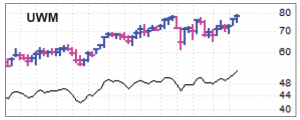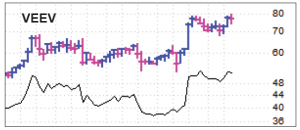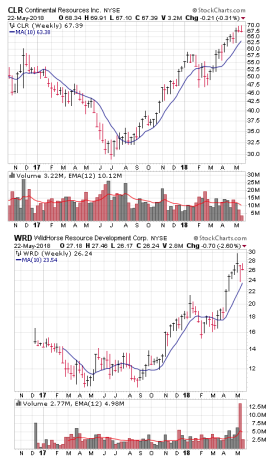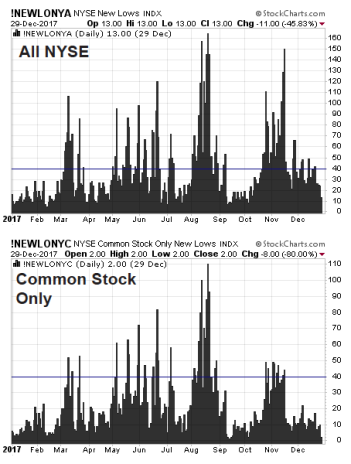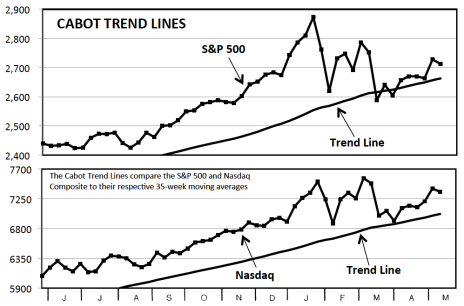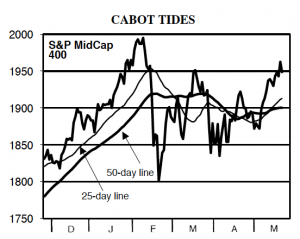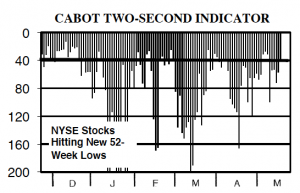The market has done a good job of holding its strong early-May upmove, and that’s kept both of our trend-following market timing indicators in positive territory. That said, what we really want to see going forward is upside follow through from the major indexes and leading growth stocks, which would go a long way toward telling us the three-month correction is over.
Cabot Growth Investor 1394
[premium_html_toc post_id="150547"]
Waiting For Follow-Through
One of the key concepts to keep in mind when you examine a stock chart is “base, breakout, follow-through.” Many people will get excited seeing a nice setup (base) that forms over many weeks, and even more will get giddy when they see a breakout from that trading range. But, while those two things are important, what counts most is upside follow-through after the breakout—it tells you the sellers are in retreat and the stock’s character has changed for the better.
The same reasoning can be applied to the market. When examining the action this year, the market’s base is represented by the three-month correction in the indexes, including myriad retests of the February lows and positive broad market divergences. Then we had the “breakout,” which in this case refers to the strength earlier this month that turned the intermediate-term trend (Cabot Tides) back up.
What about the follow-through? That’s what we’re still waiting for. The major indexes have been unable to build on their strong early-May gains, even with some “good” news (easing trade tensions with China, etc.) recently. And, under the surface, rotation has been the name of the game. Most growth stocks, for example, did very well earlier this month, though this week has produced a few potholes.
The continued choppiness isn’t the end of the world. Both of our trend-following indicators are still positive, and we’d even say that the relatively orderly consolidation in the major indexes over the past two weeks is a positive change in character—previous rallies this year quickly resulted in wild action (at best) or big selloffs (at worst). Frankly, a couple of big up days from here could be enough to get the bulls running.
Those are encouraging signs, but at this point we want more than encouragement; we need to see definitive signs that the sellers have been worn out and that the buyers are getting more aggressive. If that happens, we’ll put more money to work in new leadership, but until then, we think it’s best to keep some powder dry and take things on a stock-by-stock basis.
[highlight_box]WHAT TO DO NOW: Continue to lean bullish. We haven’t made any new buys or sells in the Model Portfolio since the last issue; we’re still holding 30% in cash. We are, however, switching Five Below and Proofpoint to Hold ratings based on their recent sluggishness. Details inside.[/highlight_box]
Model Portfolio Update
The Model Portfolio remains in a “lean bullish” stance, with around 70% invested in eight stocks and a cash position of 30%. All told, we expect continued volatility with a couple of earnings reports this week (NTNX and SPLK) and two more in the weeks ahead.
As for individual growth stocks, most are in good shape (including most of the stocks we own), but it’s still choppy out there, with a few areas showing ragged action. We’re downgrading a couple of stocks to Hold today based on some sloppiness. We’re more optimistic than not, but we want to see more strength before doing more buying.
Current Recommendations
HOLD—Five Below (FIVE 73)—We’re moving FIVE to Hold in tonight’s issue, though we don’t see anything major wrong with the chart—shares are just a few points from all-time highs. It looks like the stock is building a base here; it’s made no net progress since early January (much like the S&P 500), and its rally from a tight area around 70 quickly ran into a wall. There are short-term worries about higher energy prices and higher interest rates, which could theoretically dent the buying power of Five Below’s customers, though we don’t think that will have any real impact on the company’s growth trajectory. Having already booked partial profits a few months ago, and with an enticing growth story, we’re aiming to play our remaining position for what hopefully will be a longer-term move. A drop into the low 60s might change our thinking, but right now, if you own some, hang on and practice patience—though we see stronger names to consider if you’re doing new buying.
HOLD—GrubHub (GRUB 103)—GRUB did a nice job of quickly snapping back from its post-earnings selloff, though like most growth stocks, it has basically marked time during the past couple of weeks. Overall, it’s in a similar position to FIVE—near term, the stock is just chopping sideways, but the major growth story remains excellent and, having already booked partial profits, our goal is to ride out a bigger upmove. Fundamentally, we think GrubHub’s position as the leader in online ordering and delivery will lead to more exclusive deals with major chains. The agreement with Yum! Brands is the poster child for that sort of deal, but there’s plenty of potential with other chains—the company’s deal with Jack in the Box, announced two weeks ago, will eventually expand to hundreds of locations. Big picture, the stat to remember is that just 2% or so of takeout purchases in the U.S. are done online; as that figure grows, so will this company’s bottom line. A plunge into the mid-80s would be abnormal, but barring that, our plan is to give our remaining small position plenty of rope to digest its sharp rally from October through March. On the upside, a decisive move above 110 or would be very bullish.
BUY—Nutanix (NTNX 56)—NTNX looks like many growth stocks, with a quick rip to new highs in early May and a relatively calm, choppy dip during the past week and a half as it tests its prior high. Really, though, the stock’s intermediate-term future is likely to come down to the quarterly report, which is due out tomorrow after the close—analysts are looking for $279 million in revenue (up 46%) and a loss of 19 cents per share, but sub-metrics and the outlook will be vital as well. A drop into the mid-40s would be a red flag, but we’re still of the mind that (a) the trend toward hyperconverged infrastructure is in the early innings, (b) Nutanix is the leading player in that trend and (c) the stock’s massive-volume blastoff (buoyed in part by the firm’s jaw-dropping outlook through 2021) in the first half of March signaled that big investors were taking big positions. (Interestingly, NTNX has received some positive analyst commentary leading up to tomorrow’s report.) We’ll stay on Buy, but will have any updates if need be in the days ahead.
BUY—Okta (OKTA 50)—OKTA has whipped around on a day-to-day basis since we added shares in the last issue, but overall the stock is consolidating normally after a big run. We have noticed some top performers in the cloud software space starting to act sloppy (ServiceNow and Paycom are two examples), but most are still in fine shape, and Okta looks like a new leader in the group with an easy-to-understand growth story—as more and more companies move their operations online and to the cloud, they need identity solutions like Okta provides for both customers (JetBlue uses Okta for its booking platform) and employees (Farmers Insurance uses Okta to help its 20,000 employees securely connect to the cloud). Okta also just announced new partnerships today with VMware (integrating the firm’s identity suite into VMware’s digital workspace platform) and Facebook (integrating with Workplace, Facebook’s suite of business tools), as well as some new sign-on products of its own. If you don’t own any, you can grab some shares around here or on dips; earnings are due out June 6.
HOLD—PayPal (PYPL 81)—PayPal made waves last week by purchasing iZettle, a company that many call the “Square of Europe,” in a $2.2 billion deal that will give PayPal a major in-store presence in many new international markets (including France, Germany, Italy, Mexico and Brazil), boost its presence in many existing markets and expand its e-commerce products in the U.S., U.K. and Australia. More details on the purchase and PayPal’s overall outlook and strategy will come on Thursday, when the company hosts an Analyst Day. Right now, analysts are still looking for steady 20% to 25% earnings and free cash flow growth in the years ahead, though we’ll be eager to see if there’s any upgrade to that once they have a clearer picture of how iZettle fits in the growth story. As for the stock, it still has resistance to chew through, but PYPL has rallied nicely off its early-May lows, reacted well initially to the acquisition announcement and is just 7% or so off its high. We’ll stay on Hold for now, but a bit more strength from here would go a long way toward telling us the stock’s major uptrend is resuming.
HOLD—Proofpoint (PFPT 121)—PFPT is our second stock that’s moving to Hold tonight, as shares have dipped below their 50-day line on modest volume. Similar to FIVE, this chart is hardly a disaster—in fact, shares still have a higher lows/higher highs pattern during the past four months of tedious market action—but we think it’s prudent to switch to a Hold rating and see when support comes in. Many are wondering about Proofpoint’s suddenly mundane earnings estimates for this year (up just 14% from last year), but with a subscription business like Proofpoint, what matters more are sales, billings and cash flow growth. And on those metrics, management’s latest 2018 outlook (up 36%, 36% and 33%, respectively) looks just fine, and it wouldn’t surprise us if those figures prove conservative. All told, we still have high hopes for PFPT, and are willing to hold the stock down to 110 or so before pulling the plug. If you own some, hang on, but we’d prefer to put new money to work elsewhere.
BUY—Shake Shack (SHAK 58)—Our biggest thought when it comes to SHAK is that the stock has very likely started a major new advance because of the chart action (a two-year post-IPO bottom, a pristine-looking base and a powerful gap on earnings three weeks ago) and fundamentals (the company’s restaurant expansion plan is kicking into high gear). Near term, our goal is to give our position plenty of rope—after its big run, and with the market still choppy, shares could easily bob and weave for a while. But to this point, SHAK has held most of its gains and, barring a market meltdown, further dips are likely to bring in buyers. Back to the business, analysts see sales up 25% this year and 29% next year as the pace of new locations picks up, and we think even those figures will prove conservative should traffic trends in the sector improve. Long story short, if you don’t own any, you can buy some here, but use a loose initial loss limit in the upper 40s.
BUY—Splunk (SPLK 117)—SPLK looks great, hovering just shy of all-time highs and above its breakout point from a couple of weeks ago (near 110). That said, the real tale will be told following earnings, which will be released tomorrow (May 24) after the close, with analysts looking for sales growth of 23%, a loss of nine cents per share (though cash flow should grow nicely) and any updates on the two-year outlook the firm provided a couple of months ago. SPLK has been advancing since its initial breakout back in November (six months ago), so some selling wouldn’t be surprising; a drop below 100 could have us selling some of our shares. But we’re still thinking positively, as the growing need and uses for the company’s Big Data software platform should keep growth both quick and steady. We’ll stay on Buy but, as always, will let you know of any changes after the report.
Watch List
Alibaba (BABA 197): BABA surged to the 200 level after earnings and has traded tightly since. We believe the stock is in the mid-stages of its overall advance, and are definitely willing to buy back in on a breakout.
Continental Resources (CLR 68) or WildHorse Resource (WRD 27): As we write on page 6, energy stocks are both strong and early-stage, and while the group is always herky-jerky, there’s great potential for leaders like CLR, WRD and others.
Ligand Pharmaceuticals (LGND 191): LGND has had a couple of false starts this year, but its latest burst to new price and relative performance (RP) highs is enticing.
Spotify (SPOT 154): SPOT briefly nosed to new highs before falling back after earnings, continuing its post-IPO base. The action is fine with us, but we want to see a decisive breakout before taking a stab at it.
Twilio (TWLO 53): We’ve always liked Twilio’s growth story, as its communication platform is extremely pervasive (46,500 corporate clients!) and usage-based, so as more companies integrate its apps into their business, the more Twilio’s bottom line will grow. And now the stock is looking powerful.
Other Stocks of Interest
The stocks below may not be followed in Cabot Growth Investor on a regular basis. They’re intended to present you with ideas for additional investment beyond the Model Portfolio. For our current ratings on these stocks, see Updates on Other Stocks of Interest on the subscriber website or email mike@cabotwealth.com.
Carvana (CVNA 26) — The term “disruptive” gets thrown around a lot, but Carvana is genuinely disrupting the used-car sales industry. The company’s big idea is that it turns any online screen into a used-car vending machine. Shoppers can look at 360° pictures of cars and get a guarantee of an undamaged body and no major accidents. If you buy, Carvana delivers the car within a day or two and offers a seven-day test drive period, too. The simplicity of this buying process has produced three years of triple-digit revenue growth (although no profits yet, as the company plows cash flow back into expansion). Used cars are a $739 billion industry in the U.S. and Carvana—which now has operations in 56 markets, up from 23 a year ago—should be in around 80 markets at year-end. Profitability is a long way off, but CVNA is holding above the highs of a 10-month base and is setting up nicely.
GDS Holdings (GDS 39) — As China’s online economy grows via e-commerce, cloud services and streaming media, the need for data centers grows right along. GDS Holdings is a huge player in providing data center and colocation capacity for high volume/high power users. GDS has expanded its string of data centers by both new-building and acquisition, and added four centers in 2017 alone, with plans for seven new, self-developed centers in 2018 and beyond. GDS Holdings is another company that’s foregoing earnings in favor of expansion, but its revenue growth (54% in 2017 and 76% in Q1 2018) testifies to its potential. GDS came public at 10 in November 2016, slumped to 7 in June 2017, then started a powerful rally that topped 30 earlier this year and has resumed after a three-month consolidation. It’s extended to the upside right now, but it has the potential to be the Equinix of China.
ProShares Ultra Russell 2000 (UWM 78) — The Russell 2000 Index of small-cap stocks has been hitting new highs, leading all major indexes. And while this isn’t a raging bull market and there are plenty of cross currents, that kind of strength in small-caps is a possible opportunity. The ProShares Ultra Russell 2000 ETF delivers twice the daily performance of the Russell 2000, and would be an easy way to get a foothold in the market. UWM ran from 56 at the end of 2016 to 71 as 2018 dawned and after the January/February dip has pushed out to 79. The Russell 2000 mix of small cap growth stocks is volatile, but it definitely has momentum on its side right now. Try to buy on dips.
Veeva Systems (VEEV 77) — Software that helps companies manage relationships with customers has been a popular niche for years, and Veeva has the leading solutions for that and other functions that are specifically aimed at the biotech and pharmaceutical industries. Veeva’s software suite helps clients manage clinical trials, share data, deal with regulatory authorities, improve sales teams and a lot more. The company’s client count is growing steadily, and subscription services (which means recurring revenue) account for 80% of revenue. Plus, the firm’s Vault content management platform is even gaining traction in industries outside of life sciences. The company’s earnings report in February beat on both revenue and earnings, causing a gap to new highs. When Veeva springs its Q1 report tomorrow (May 24) after the close, analysts are looking for $189 million in revenue and 31 cents per share in earnings. VEEV has been stalled under resistance at 78 for a few months, making a nice base if the news is good.
Early Stage Opportunities in Energy
During one of our periodic studies of our past trades, we looked back on our history with commodity stocks. And it wasn’t pleasant! Our success rate with commodity names has been way below that of growth stocks. The main reason was that we usually bought late in the uptrend, after a sector had been running for a few months or longer; the stocks often began a correction a couple of weeks after our entry and knocked us out.
Because of that, even as commodity areas languished in 2017, we’ve been keeping an eye on them, thinking the next sustained uptrend would provide a good (early stage) opportunity in the group. That time appeared to have come in December, when many energy stocks began to get going—we bought Diamondback Energy (FANG) but got out a few weeks later as the general market correction snuffed out the rally.
Now, though, energy stocks are strong again, and big picture, it still looks early in the move. The SPRD Oil & Gas Fund (XOP) etched one big bottoming base last year following the horrific 2015-2016 bear market in the group. We’ve been closely monitoring a bunch of names and have tried to bring some to your attention in recent issues. A couple of our favorites:
Continental Resources (CLR) was the first explorer/driller to hit all-time highs during this rally, so it naturally got our attention. The firm’s acreage in the Bakken and Oklahoma produces very solid production growth (up 34% in the first quarter), and not only are earnings booming but management expects 2018 to produce a ton of free cash flow, which is a rarity in the industry. Average well returns are north of 100% (payback period of just eight months), another plus. It’s not the fastest-moving name, but we think it’s an emerging blue chip and possibly a liquid leader in the group.
On the wilder side of things is WildHorse Resource Development (WRD), which has the second largest acreage position in the Eagle Ford shale in Texas. After years of getting everything in place, the firm is embarking on a massive growth plan—management sees output this year up 80% or so (it was up nearly 200% in the first quarter!), and with more than 3,100 potential drilling locations, there’s no reason growth won’t remain rapid for many quarters to come. Analysts see earnings surging to nearly $2 per share this year and rising further in 2019.
There are other names to consider, including WPX Energy (WPX) and Pioneer Resources (PXD). But our overall point is that energy stocks are both strong and appear to be coming off a major bottoming area, a combination that raises the odds of a sustained advance.
Thinking about the Two-Second Indicator
Way back in the early 1990s, we pored over new-high and new-low data on the NYSE, looking for something that could be gleaned from this data on the broad market. It turns out new highs weren’t too helpful; if anything, they were often a contrary measure, though their record was spotty at best.
The number of stocks hitting new lows, though, showed promise. For many decades, healthy market environments almost always saw the number of new lows below 40 on most days, while declining markets saw the daily figure usually north of 40. Even more important was that, prior to every bear market, we saw weeks of plus-40 readings—even as the Dow was hitting new highs! Thus, the Two-Second indicator was born, and despite changes in the numbers of stocks being listed on the NYSE, that 40 threshold worked well for a couple of decades.
But the makeup of the “broad market” has changed in recent years, with tons of bond-like securities (preferred stocks, bond funds) or equity/income hybrid securities like REITs and MLPs. That’s caused some hiccups in the indicator as interest rates have glided upwards. Last year, for instance, we saw repeated flare-ups in the number of stocks hitting new lows (see chart to the right), yet the S&P 500 had one of its smoothest up years in history, and the Model Portfolio did far better.
That said, the fundamental idea behind the indicator (the broad market weakens for weeks before a major top) remains valid, so we’re looking at methods of improving it. One possibility: Looking at just common stocks (chart to the right). While not perfect, the negative readings were far less extreme last year. We’re also perusing other broad market measures (like percent of stocks above their 50-day or 200-day moving averages, etc.) to see if something sticks.
Right now, we’re keeping the Two-Second Indicator as is; the recent plus-40 readings tell us that there are plenty of cross currents in the market. But after 25 years, we’re aiming to upgrade the indicator; in the meantime, as always, we’re placing most of our emphasis on our trend-following measures and the action of leading stocks.
Cabot Market Timing Indicators
Both of our trend-following indicators remain bullish, and the major indexes and most stocks have done a nice job holding their gains from early May—both reasons to lean bullish. But we want to see some upside follow through before becoming heavily (or fully) invested.
Cabot Trend Lines: Bullish
With all the news-driven moves, it pays to have a time-tested longer-term measure to filter out the noise. That’s our Cabot Trend Lines, and despite the various worries, it’s been clearly positive for more than two years now (!), continually reminding us that the bull market is intact. Last week, the S&P 500 (by 1.9%) and Nasdaq (by 4.8%) closed nicely above their respective 35-week moving averages, which keeps the longer-term trend pointed firmly up.
Cabot Tides: Bullish
Our Cabot Tides remain on their Buy signal from two weeks ago, with all of the major indexes (including the S&P 400 MidCap, shown here) trading nicely above their lower (now 50-day) moving averages. Of course, some indexes look better than others, and most still have some overhead to chew through. But the Tides tell us that the intermediate-term trend is up, which, combined with the positive longer-term trend, is a reason to keep your optimist’s hat on.
Two-Second Indicator: Unhealthy
The Two-Second Indicator still can’t get out of its own way, with just two or three sub-40 readings before the number of new lows expands again. Much of this could be due to higher interest rates, and we’re looking to improve (or possibly replace) the indicator, possibly by looking at common stocks only—on that basis, the number of new lows has been very well behaved since the early May low. See page 7 for more.
[premium_html_footer]
Send questions or comments to mike@cabotwealth.com.
Cabot Growth Investor • 176 North Street, Post Office Box 2049, Salem, MA 01970 • www.cabotwealth.com
All Cabot Growth Investor’s buy and sell recommendations are made in issues or updates and posted on the Cabot subscribers’ website. Sell recommendations may also be sent to subscribers as special bulletins via email and the recorded telephone hotline. To calculate the performance of the portfolio, Cabot “buys” and “sells” at the midpoint of the high and low prices of the stock on the day following the recommendation. Cabot’s policy is to sell any stock that shows a loss of 20% in a bull market (15% in a bear market) from our original buy price, calculated using the current closing (not intra-day) price. Subscribers should apply loss limits based on their own personal purchase prices.
Charts show both the stock’s recent trading history and its relative performance (RP) line, which shows you how the stock is performing relative to the S&P 500, a broad-based index. In the ideal case, the stock and its RP line advance in unison. Both tools are key in determining whether to hold or sell.
THE NEXT CABOT GROWTH INVESTOR WILL BE PUBLISHED JUNE 6, 2018
We appreciate your feedback on this issue. Follow the link below to complete our subscriber satisfaction survey: Go to: www.surveymonkey.com/marketlettersurvey
Neither Cabot Wealth Network nor our employees are compensated by the companies we recommend. Sources of information are believed to be reliable, but are in no way guaranteed to be complete or without error. Recommendations, opinions or suggestions are given with the understanding that subscribers acting on the information assume all risks. © Cabot Wealth Network. Copying and/or electronic transmission of this report is a violation of U.S. copyright law. For the protection of our subscribers, if copyright laws are violated, the subscription will be terminated. To subscribe or for information on our privacy policy, call 978-745-5532, visit www.cabotwealth.com or write to support@cabotwealth.com.
[/premium_html_footer]



